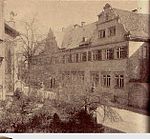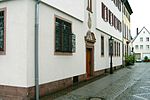Aristocratic courts in Aschaffenburg
The aristocratic courts in Aschaffenburg were the residences of the aristocratic servants at the court of the Mainz elector - archbishop ( vice-dominus , privy councilor , steward , bailiff ).
history
In addition to the colleges , seat of the canons of the collegiate monastery St. Peter and Alexander in the Aschaffenburg upper town, there were also some important noble courts in Aschaffenburg. Since the city was a preferred place of residence for the Archbishops of Mainz, many nobles also settled in Aschaffenburg. Most of the stately houses were in the city center.
The aristocrats lived in wooden houses until the 13th century, later timber-framed dominated. Magnificent buildings were built in the 17th century (Osteiner Hof, Schönborner Hof).
The von Wasen family is one of the oldest nobles living here . Around 1344 Nicolaus von Wasen bequeathed his estates east of the upper Herstallstrasse - Riesengasse - Roßmarkt to the former Heylands brewery to his descendants.
The noble houses were named after their owners and kept this name even after the later change of ownership.
Noble courts
Osteiner-Bassenheimer Hof
- Through an additional acquisition in 1696, Johann Franz Sebastian Freiherr von Ostein (born November 4, 1652 Puntrut ; † June 24, 1718 Aschaffenburg), Oberamtmann zu Amorbach , was able to build a new aristocratic court in the property at Dalbergstrasse 78. In 1727 his daughter Maria Antonia Franziska von Ostein (1710–1788) married the imperial chamberlain Rudolph Johann Graf Waldbott von Bassenheim (1680–1731). Their son Johann Maria Rudolph Count Waldbott von Bassenheim (1731–1805) inherited the property from his uncle, Franz Wolfgang von Ostein (1727–1778) provost of the collegiate monastery of St. Burkard in Würzburg, which was owned by Count Waldbott from 1778 to 1852 from Bassenheim was. In 1852, the director of the Aschaffenburg Forestry University, Karl Stumpf, bought the building; The purchase price agreed was FL 12,000. In 1873 he sold the farm for 27,000 fl to the Jewish cattle dealer Josef Feldmann from Kleinwallstadt, whose descendants were deported and murdered in 1942. The Bassenheimer Hof, expropriated, went to the German Reich . Destroyed in the last days of the war, later demolished, today access to Willigis Bridge.
Collenberger- Kronberger- Dalberger Hof
- In 1542, Eberhard Rüdt von Collenberg , the Electorate of Mainz, acquired the property at Schlossgasse 8, which had been in the possession of the St. Peter and Alexander Monastery since 1331, and built his court there. In 1589 Hartmut von Kronberg ( Vizedom from 1578 to 1598) built the "Kronberger Hof" on the site, a three-winged Renaissance complex with volute gables . In 1612 the barons von Dalberg , treasurers of Worms, bought the property and sold it in 1715. Cardinal Damian Hugo Philipp von Schönborn-Buchheim , where the Teutonic Order established a commander in 1744 under the name “ German House ”. After secularization in Bavaria , the sovereign Grand Duke Karl Theodor von Dalberg became the owner in 1806 . The Aschaffenburg City Theater was built here in 1811 .
Echterhaus - Ingelheimer Hof
- "The large Ingelheim garden between Treibgasse and Seilergang, on the opposite side of the house" has been the name of the property for centuries, acquired from the donation in 1456 by Hamann Echter II. Von und zu Mespelbrunn (1427–1480), Vizedom in Aschaffenburg. In 1651 Maria Ottilia (1629–1701), the last real woman from and to Mespelbrunn, became the sole heir of the Aschaffenburg house. On October 4, 1658, her husband Philipp Ludwig Freiherr von Ingelheim (1627–1661) took over all rights and duties of his wife. He and his descendants were named "Counts of Ingelheim" by imperial decree . Real von und zu Mespelbrunn " . The real house became the Ingelheimer Hof. In 1927 Philipp Rudolf Anselm Franz Graf von Ingelheim sold the property in Treibgasse 7 to the Institute of the English Misses in Aschaffenburg . They used the farm buildings, built a kindergarten and a wafer bakery. As part of the centralization of the Maria Ward School in Schweinheimerstraße, the land and buildings were sold. The Catholic Church Foundation St. Agatha (Aschaffenburg) acquired the Ingelheimer Hof in 1961 as a community center with a kindergarten.
Gonsroder Hof
- The noble family von Gonsrod came from Gondsroth Gonsrodt, Gunsrode, Gonsrode, Gonsrade . From 1480 until it died out in 1597, members of the family lived in Steingasse 4. At the beginning of the 16th century the house "Zum Rindsfuß", 1671 "Haus zum´Affen", 1806 "Zum Mainzer Hof" it was "Hotel Stadt" in the last century Mainz ". The facade of the residential and commercial building is now a listed building.
Greifensteiner Hof
- The property at Metzgergasse 11-13 and the property at Webergasse 6 that adjoins it at the back are named after Junker Johann von Sayn. Greifenstein. Mainly inhabited by canons, it housed its master builder Georg Ridinger (baptized July 25, 1568 in Strasbourg; † November 5, 1617 in Aschaffenburg) during the construction period of Johannisburg Palace (1604–1614 )
Gudenus farm
- The house at Webergasse 1 belonged to the electoral state government until the 18th century and was sold in 1750 to Colonel Sergeant Freiherr von Gudenus, whose family lived there until 1818. Destroyed in the Second World War, rebuilt in 1956, it was used as the rectory of the parish of Our Lady (Aschaffenburg) . The coat of arms of those of Gudenus is placed on the inside of the gate entrance.
Hettersdorf-Hof
- The Franconian noble family von Hettersdorf had their possessions in the suburb on the Wermbach. In 1435 an interest register mentioned "Hus vnd Hoff bey dem nvwen Borne" of the Lords of Hettersorf, Burgmannen zu Aschaffenburg. 1461 Heydersdorf's house (Wernbach), 1551 Heddersdof's house at Rauff und Bahren. In the Hettersdorf family archive in 1773, Franz Gottlieb von Hettersorf is named as the owner of the property at the "Nonnenhof" of the Schmerlenbach monastery near the "Heißen Stein" in Aschaffenburg. The Hettersdorf owned the farm until 1828, after which it changed owners. After the war there was a Caritas retirement home there, which was demolished in 1962 as the road was widened. A heraldic cartouche (marriage coat of arms) Faust von Stromberg - von Hettersdorf is attached above the portal on the house wall Schönborner Hof - Storchennest .
Hoheneck-Hof
- The barons of Hoheneck , a Rhineland-Palatinate nobility family, owned houses and estates in Aschaffenburg in the 17th century. In 1602, Johann Philipp von Hoheneck, Kurmainzer Privy Councilor, Obersthofmarschall and Vizedom von Aschaffenburg, who died in 1638, built a farm on the previous property of "those von Pflug" (Treibgasse, Nebensteingasse, Steingasse), which was owned by the family until 1794. On the northern part, the cinematograph owner Fritz Rüth built an art nouveau theater in 1912 , the "Union-Kino" which was closed in 1964.
Hohenloher Hof
- A "Hohinloher Hof" is also mentioned in the 14th century in the Dalbergstrasse / Rathausgasse area, which was no longer mentioned after 1383, divided into various properties.
Rienecker Höfe
- The Counts of Rieneck also owned several town courts in Aschaffenburg until 1559. In 1209 Heinrich Count von Rieneck was provost in Aschaffenburg, in 1271 Count Ludwig and Gerhard von Rieneck owned a farm in Aschaffenburg. In 1363 the city bought a house (Dalbergstrasse 26) from Edelknecht Gundelwin von Rieneck in order to set up a town hall there.
- The corner house of the former Vizedom Philipp Johann von Rieneck at Sandgasse 33, which burned down in 1458, is referred to in literature as the court of the Counts of Rieneck to the "Rachborn". The house at Pfarrgasse 8 is said to have been a Counts Rienecker Hof before 1500, which passed into private ownership after the Counts of Rieneck died. The Rienecker Höfe have been privately owned by Marcel and Dominique Aulenbach since 2007
Salm's Palace
- The three-wing complex with the wine press house opposite had the canon and later dean (Johann) Georg Wenceslaus (von) Hoffmann built in 1751–56 as a prebend house and donated it to the St. Peter and Alexander monastery. In earlier times there was also a mint on the site. This is why the palace is also called the Kuria "Zur Alten Münze". From 1820 the palace was the seat of the district and city court. In 1857 it was acquired by Karl Anton Maximilian Freiherr von Dalberg zu Dačice (1792-1859). In the Second World War, the main wing in particular was destroyed, except for the surrounding walls. The ruins of the Salm'schen Palais were sold by their last private owner, Franz-Karl Prinz zu Salm-Salm (1917–2011), to the city of Aschaffenburg in 1953 , which they demolished in 1969 after initial renovations, with the exception of the wine press house. Since 1972 the old style "Salm'sche Palais" has been the seat of Stadtbau Aschaffenburg GmbH. The cast-iron balustrade over the vineyard walls in the garden probably comes from the Ludwigsbrücke, which was demolished around 1968 (today Willigisbrücke).
Schönborner Hof
- In 1676 by Vizedom Melchior Friedrich Graf von Schönborn and his wife Sophia Maria Anna geb. Boyneburg , built according to plans by the Mainz Capuchin Father Mathias von Saarburg, was inhabited by the family until 1832. Since then, in the possession of the city with various uses, it has housed the Natural Science Museum (left) and the City and Abbey Archives (right) since 1980.
Beguinage
- The Beguine Foundation goes to Hans III. back from Gonsrod. He owned a piece of land in Treibgasse, which he donated to the Beguines in 1527. The Beguines, a community of pious women between religious and laity, originated in the middle of the 13th century around Liège in Belgium . The “gray beguines” lived in small groups and offered social help and nursing. Cardinal Albrecht von Brandenburg (1490–1545) made the Frankfurt widow Agnes Pless, b. Strauss († 1547), with whom he lived in a marriage-like relationship and who was a successful business woman, became the head of a beginner's monastery that he had founded in Aschaffenburg's Schöntal. In 1560 the beguinage was closed and the building fell into disrepair.
City courtyard of the Schmerlenbach Benedictine monastery
- In 1350 the Schmerlenbach Monastery acquired the property next to the "Fraw-Lisen-Hof" (named after the wife Else - Lise of the knight Siebold III. Von Weiler) Brennofengasse / Am Heißen Stein and built a town courtyard with a house, barn, stables and there walled garden. In 1609 a house with two floors, a basement and a courtyard entrance was built there. As part of the secularization in Bavaria with which the Benedictine monastery Schmerlenbach was also dissolved, the ancestors of the painter and honorary citizen of the city of Aschaffenburg Adalbert Hock acquired the property.
See also
Collegiate courts in Aschaffenburg
literature
- Alois Grimm: Aschaffenburg house book. Volume I: Dalbergstrasse-Stiftsgasse-Fischerviertel History and Art Association eV, Aschaffenburg 1985, ISBN 3-87965-007-3 .
- Alois Grimm, Monika Ebert, Peter Fleck, Ernst Holleber u. a .: Aschaffenburg house book. Volume II: Old town between Dalbergstrasse and the castle, Mainufer-Mainbrücke-Löherstrasse. Geschichts- und Kunstverein eV, Aschaffenburg 1991, ISBN 3-87965-053-5 .
- Alois Grimm: (Monika Ebert, Peter Fleck, Ernst Holleber and others): Aschaffenburger Häuserbuch. Volume III: Urban area between Sandgasse, Roßmarkt, Betgasse and Wermbachstraße. Geschichts- und Kunstverein eV, Aschaffenburg 1994, ISBN 3-87965-063-2 .
- Alois Grimm †: (Monika Ebert, Peter Fleck, Ernst Holleber and others): Aschaffenburger Häuserbuch. Volume IV: Herstallstrasse with Entengasse, Landingstrasse with market square, Steingasse with Nebensteingasse and Friedrichstrasse. Geschichts- und Kunstverein eV, Aschaffenburg 1996, ISBN 3-87965-071-3 .
- Alois Grimm †: (Monika Ebert, Ernst Holleber): Aschaffenburger Häuserbuch . Volume V: Kapuzinergasse and Kapuzinerplatz, Karlstrasse, Erthalstrasse between Ridingerstrasse and the judicial building, Treibgasse and Agatha, Strickergasse, Luitpoldstrasse, enlarged Schloßplatz with market. Geschichts- und Kunstverein eV, Aschaffenburg 2001, ISBN 3-87965-084-5 .
- Monika Ebert: Aschaffenburg house book. Volume VI: Development of the Cityscape and Urban Life. Geschichts- und Kunstverein eV, Aschaffenburg 2009, ISBN 978-3-87965-113-9 .
Individual evidence
- ↑ Monika Ebert: Volume VI: Development of the cityscape and urban life. Aschaffenburg 2009, ISBN 978-3-87965-113-9 .
- ^ Ostein, Johann Franz Sebastian Freiherr von. Hessian biography. In: Landesgeschichtliches Informationssystem Hessen (LAGIS).
- ↑ Bernhard Peter: The whale pods and the Waldbott from Bassenheim.
- ↑ Personal database Germania-sacra - Franz Wolfgang von Ostein
- ↑ List of stumbling blocks in Aschaffenburg
- ↑ Alois Grimm: Aschaffenburg house book . Volume I:
- ↑ Volume II: see above
- ↑ Volume V: so
- ↑ Volume IV: see above
- ↑ Volume II: see above
- ↑ Volume II: see above
- ↑ Volume III: see above
- ↑ Volume IV: see above
- ↑ Volume I: so
- ↑ Volume I: so
- ↑ Volume IIIs.o.
- ↑ Volume II: see above
- ↑ Volume I: so










